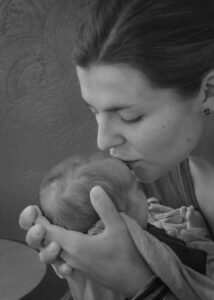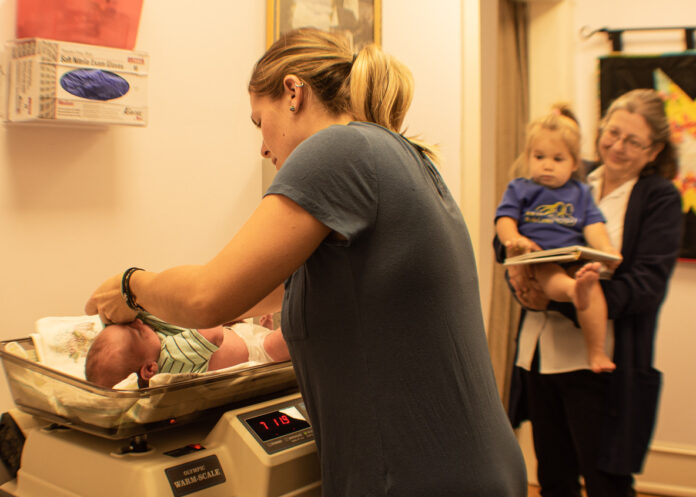Among many similar national headlines, a recent Vox article called “The babies keep coming”: What the coronavirus pandemic means for people giving birth speaks to the fact that a lot of people are curious about what it looks like to give birth at home or in a birth center right now, given the national situation.
Another article in The Atlantic titled Call the Midwife: Why a growing number of U.S. mothers are turning to midwives, rather than physicians, for prenatal care, labor, and delivery discusses at length why more and more expecting parents are choosing midwifery.
Perhaps the best timing is now more than ever to move birth out of the hospital. And while choosing to give birth assisted at home or at a birth center could protect women, their newborns, and their families in the midst of a viral pandemic, it actually could offer relief to hospitals, too.
As local cases of COVID-19 increased, we’ve seen hospitals place more restrictions on family members, fielded concerns about new mothers being separated from newborns, and witnessed an overall increase in anxiety about hospitalization. I have been getting phone calls from women considering transferring to our birth center for care or interested in discussing home birth options to avoid contact with the hospital.
Helping women to stay home or utilize freestanding birth centers could allow hospital workers to care for the sickest individuals and is better aligned with the social distancing measures that we have to take in every other sphere of our lives right now.
Though birthing outside of the hospital may be a great fit for many women, it won’t be for everyone, despite the pandemic.
Women who are generally healthy and have a “low-risk” pregnancy are ideal candidates for birthing outside of the hospital. “High risk” pregnancies are not ideal for that setting. A mother who smokes, is severely overweight, or is having twins, for example, would be included in that group.
An expectant mother may consider contacting a local midwife or birth center to gauge compatibility with her particular needs. Most midwives can be found on a Google or Facebook search. The American Association of Birth Centers, Virginia Midwives Alliance, or the Virginia Affiliate of the American College of Nurse Midwives may also be able to help locate a local midwife.

Additionally, there is now a Facebook group called Alternative Birthing Resources of the Greater Roanoke, Virginia Area to help create a community around women searching for alternatives to conventional means for birth, where they can access local midwives, doulas, and other professional service providers outside of the hospital, as well as classes and events that are locally relevant. Roanoke area service providers who are not yet part of the group may also join.
Overall it’s exceptionally less expensive to hire a licensed professional midwife or a licensed certified nurse-midwife who provides services outside of the hospital setting, and it’s pretty straightforward to transfer care. Some insurances pay for part of the costs and some won’t pay any of the costs for out of hospital births. However with Covid-19, some insurance companies may make an exception.Certain midwives don’t accept insurance because it keeps their cost of care lower. Still others, like New Life Birth Center, take prepayment and then will bill out-of-network after the baby comes to get the family reimbursed.
If parents don’t have out-of-network coverage, they might contact their insurance company to see if it will make an exception due to the COVID-19 crisis.
One might wonder how an out-of-hospital birth can compare to traditional hospital births. Compared to the hospital setting, generally speaking, birth centers and home births experience some of the following differences:
Ability to eat and move around during labor
- Use of doppler to monitor fetal heartbeat (required to reduce risk of C-section)
- Access to birthing tubs for both labor and delivery, which is an excellent way to manage pain naturally
- Pain medications not used, including epidurals
- Cesarean sections (C-sections) not performed
- Limited interventions so as to decrease need for C-sections
- Patient control over personal aspects of birth experience (which people are present, father’s participation, birthing philosophy, skin-on-skin, etc.)
- Robust access to lactation/nursing support
IV fluids, antibiotics, oxygen, and medications to stop postpartum bleeding are all typically accessible. If a hospital intervention becomes medically necessary, the patient would be transferred.
My rule of thumb for navigating these various options is that a woman will labor best where she feels safe, supported, and in control. For some women it’s in the hospital, for some it’s at home, and for some it’s in a birth center. New Life Birth Center is available to help women walk through making such an important personal decision.
Karen Winstead is the staff certified nurse midwife at New Life Birth Center with 35 years and counting of combined nursing and midwifery experience.


